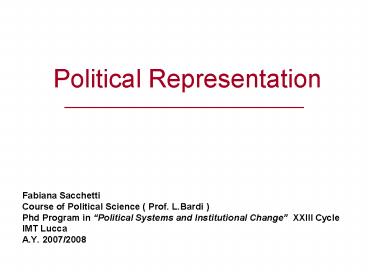Political Representation - PowerPoint PPT Presentation
1 / 16
Title:
Political Representation
Description:
setting within it takes place (political context) ... One-to-one relationship between a legislator and its constituency. Collective Representation ... – PowerPoint PPT presentation
Number of Views:143
Avg rating:3.0/5.0
Title: Political Representation
1
Political Representation
- Fabiana Sacchetti
- Course of Political Science ( Prof. L.Bardi )
- Phd Program in Political Systems and
Institutional Change XXIII Cycle - IMT Lucca
- A.Y. 2007/2008
2
The concept of Political Representation
- Complexity and multidimensionality
- Democratic Political Representation
- ( Regime Representative Democracy )
- ( Institutions Parliaments )
3
Basic definitions
- Key elements relationship between a principal
(represented) and an agent (representative)
object represented (opinions, interests ...)
setting within it takes place (political context) - Institutionalised system of political
responsibility,realised through the free
electoral designation of certain fundamental
political organisms ( mainly Parliaments ) - (M. Cotta, 2002)
4
Different views of Representation(Hanna Pitkin
The Concept of Representation, 1967)
1) Formalistic Representation 1 a) Authorization (Conferral of authority, Alienation) Means by which the representative obtains his status 2 a) Accountability (Responsibility, Procedural dimension) Responsiveness of representatives to the constituents / Ability of constituents to punish their representatives
2) Substantive Representaton Content of the actions of the representative taken in the interest of the represented
5
3) Descriptive Representation Representation as a mirror, as accurate resemblance of the represented Reproduction of the characteristics of the represented (selection of the characteristics gender, status, ethnicity, professional condition, etc.)
4) Symbolic Representaton Ways that the representative stands for the representated Meaning that a representative has for the represented ( presidents, flags, hymns, buildings, etc.)
6
Types of Legislative Representation(Loewenberg
and Patterson Comparing Legislatures, 1979)
- Foci of Representation
- ( Who - The kind of constituency the
representatives think they represent ) - 1. Geographic Constituencies
- 2. Party Constituencies
- 3. Other Constituencies (ethnic groups, social
classes, genders, interest groups ...)
7
- Styles of Representation
- ( How The way the representative responds to
the represented ) - 1. Delegate ( follows the expressed
preferences of the constituents ) - 2. Trustee ( follow his own judgements )
- (Burke Parliament is not a Congress but a
Deliberative Assembly) - 3. Politico ( fits his style of representation
to the political circumstances he find himself)
8
- Components of Responsiveness
- ( What The kind of expectations the
representatives respond to ) - 1. Policy Responsiveness
- 2. Service Responsiveness
- 3. Public good Responsiveness
- 4. Symbolic Responsiveness
9
Dyadic and Collective Representation(R.
Weissberg, Collective vs Dyadic Representation
in Congress, 1978)
- Dyadic Representation
- One-to-one relationship between a legislator and
its constituency - Collective Representation
- The extent to which institutions as a whole /
collectively represent a people - ( gt Burkes Virtual Representation )
10
- Collective representation is not a substitute to
Dyadic representation but exists in addition to
it - ( Citizen preferences can be represented
collectively even if particular legislators
ignore their constituency or betray their
expectations ) - It can explain the lack of citizen concern and
involvment in legislative elections, and their
willingness to tolerate unresponsive legislators
11
Changing political realities and changing
concepts of representation
- International and domestic political
transformations international, transnational and
non-governamental actors, as well as social
movements, interest groups and civic
associations, play important role in advancing
public policies in behalf of citizen, acting as
representatives of them - Focus on authorization and accountability within
nation states and on formal representation is no
longer satisfactory
12
Revisiting Democratic Representation some
contributions
- J.Mansbridge Rethinking Representation
- ( American Political Science Review 2003 )
- N. Urbinati Representation as Advocacy
a study of Democratic Deliberation - ( Political Theory, 2000 )
- I.M.Young Inclusion and Democracy
- ( Oxford University Press, 2000 )
13
- Rethinking Representation
- ( J. Mansbridge, 2003 )
- Multiple forms of representation in modern
democracies
1. Promissory Representatives focus on what they promised to do during the last electoral campaign V t1 ? R t2 (Traditional model)
2. Anticipatory Representatives focus on what they think constituents will approve in the next election R t2 ? V t3 (Retrospective Voting) Education or Manipulation of the voter
3. Gyroscopic Representative looks within his own background to derive interests and principles V t1 ? System t2
4. Surrogative Representative represent constituents outside his distric, party, etc. (collective representation, virtual representation) Monetary Surrogacy / Pure Surrogacy
14
- Representation as Advocacy
- ( N. Urbinati, 2000 )
- Not the aggregation of interests but the
preservation of disagreements necessary for
granting liberty - Not focusing on formal procedures of
deliberation at the expense of examining
sources of inequality within civil society - Importance of the domain of opinion and consent
formation
15
- Inclusion and Democracy
- ( I. M. Young, 2000 )
- Representation should not be a relation of
identity but a differentiated relationship the
legitimacy of a representative is not primarly
a function of his similarity to the represented - Recognizing how representative institutions
include as well as they exclude - Democratic representation as a dynamic process
16
Bibliography
- Cotta M., Della Porta D., Morlino L. Scienza
Politica - (Il Mulino, Bologna, 2002)
- Burke E. Speech to the Electors of Bristol (3
Nov 1774) - Loewenberg G. and Patterson S.G. Comparing
Legislatures - (Little, Brown Co., Boston,1979)
- Mansbridge J. Rethinking Representation
- (The American Political Science Review, 2003)
- Pitkin H. The Concept of Representation
- (University of California Press, Berkeley,1967)
- Urbinati N. Representation as Advocacy a study
of Democratic Deliberation (Political Theory,
2000) - Young I.M. Inclusion and Democracy
- (Oxford University Press, New York, 2000)
- Weissberg R. Collective vs Dyadic Representation
in Congress - (The American Political Science Review 1978)






























![[DOWNLOAD]PDF The Price of Democracy: How Money Shapes Politics and What to Do about It PowerPoint PPT Presentation](https://s3.amazonaws.com/images.powershow.com/10120492.th0.jpg?_=20240905129)
